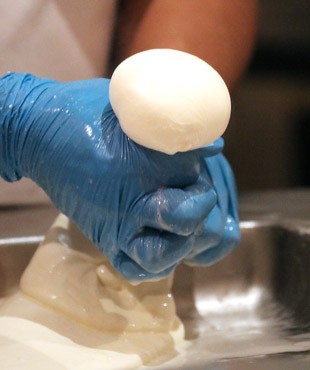Mozzarella cheese
Mozzarella, a soft and elastic white cheese, is traditionally made from buffalo's milk. It stands as one of the most esteemed pasta filata (stretched curd) cheeses, originating from the Southern Italian provinces of Campania.
 |
| Mozzarella cheese. Courtesy: Mussi Katz |
Mozzarella possesses a mild flavor profile but readily absorbs the flavors of accompanying ingredients, permeating its moist, porous layers of spun curd. This, coupled with its remarkable elasticity when melted, contributes to its widespread popularity.
Similar to many other fresh cheeses, it serves to enhance the texture rather than imparting a distinct taste to a dish.
Production guide of Mozzarella cheese:
Mozzarella's name is derived from the term mozzare, which means cutting by hand. It is also known as the stretched or spun curd cheese. In this process, fresh curd is heated in whey before being stretched or kneaded until the strands reach a point where they do not break when pulled.
Traditionally, Mozzarella cheese is crafted using water buffalo milk, although cow's milk is increasingly common, especially in the US. Cow-milk Mozzarella offers a mild flavor, albeit not as soft as its water buffalo counterpart. To produce 1 kg (2.2 lb) of cheese, a cheesemaker typically requires 8 kg (18 lb) of cow milk, whereas only 5 kg (11 lb) of buffalo milk is needed.
The conventional process for making Mozzarella cheese, or a Mozzarella-like cheese, involves the following steps:
Initially, the milk is strained to eliminate any big particles soon after it is obtained from the animal and pasteurized.
Then, milk is acidified to ferment using natural whey culture or thermophilic lactic acid bacteria.
Coagulation: The milk is heated up to 36-38°C and then rennet is added. This temperature favors the coagulating effect of the rennet enzymes.
Cutting the curd: Once the milk starts curdling, it is subjected to cutting using a metal curd knife to expel the whey (a liquid made up of water, lactose, and proteins) from the curd. The cutting process must be divided into two phases: In the first phase, the curd is cut into big cubes using a knife. Once major portions of whey are separated, the cubes are further reduced into 2-3 cm-size granules.
Curd maturation: Allow the curd to mature further under whey at a temperature of about 36°C.
Stretching: Next, the curds are immersed in hot water (around 95°C) and stretched. The stretching causes a significant rearrangement in the curd structure and this, in turn, creates mozzarella's unique textural and melting characteristics. Traditional manual stretching is done with the help of wooden sticks and a ladle.
The stretching is usually considered finished when the cheese becomes shiny and homogeneous.
After stretching, it is handled with great care, performing characteristic movements that finish with the "mozzatura" to obtain buffalo Mozzarella cheese balls. The curd is first immersed in cool water and then in slated brine. The cheese is also made in different shapes like bocconcini (little balls), perline (little pearls), ciliegine (little cherries), as well as trecce (braids shape), and nodini (small knots).
The buffalo mozzarella cheeses can be packed in small plastic bags or trays. It is then kept at 15°C. The product is usually eaten within 1 or 2 days.
Health benefits of Mozzarella cheese
Mozzarella is the most famous, traditional Italian soft cheese. Non-salted and non-fat mozzarella is low in calories, protein-rich, very nutritious, and mineral-rich dairy products. /3.5 oz (100 g) fresh skim-milk (lite) mozzarella carries just 141 calories against 299 calories of whole milk mozzarella.
3.5 oz (100 g) of it provides 22.2 g of high-quality protein (39.64% of Recommended daily allowance) that is complete in all essential amino acids necessary for growth and development and robust health.
Mozzarella is a gluten-free dairy product which makes it an important food item that is rich in protein, minerals, and vitamins for Celiac disease people.
It is a rich source of calcium (505 mg/3.5 oz or 50.5% of DA), zinc, and phosphorous (354 mg/3.5 oz or 50% of DA); and together with vitamin-D, these minerals help in the growth and development of bone and teeth, especially in the children.
Mozzarella is deemed as n healthy dairy product since most of the milk constituents undergo enzymatic/biochemical changes into more easily digestible and health-benefiting products.
Mozzarella contains all the vitamins available in the milk, both fat-soluble and B-complex groups of vitamins. It is particularly rich in vitamin B-12 (2.28 mg or 95% of DA/100g) and vitamin A (676 IU/100g).
Mozzarella also holds modest levels of copper, selenium, iron, pyridoxine, vitamin E, and manganese. These minerals and vitamins take part in various metabolic functions in humans.
| Principle | Nutrient Value | Percent of RDA |
|---|---|---|
| Energy | 299 Kcal | 15% |
| Carbohydrates | 2.4g | 2% |
| Protein | 22.2 g | 39.64% |
| Total Fat | 22.1g | 110.5% |
| Dietary Fiber | 0g | 0% |
| Vitamins | ||
| Folates | 7 μg | 2% |
| Niacin | 0.104 mg | <1% |
| Pyridoxine | 0.037 mg | 3% |
| Riboflavin | 0.283 mg | 22% |
| Thiamin | 0.03 mg | 2.5% |
| Vitamin-A | 676 IU | 22.5% |
| Vitamin-B12 | 2.28 μg | 95% |
| Vitamin-C | 0 mg | 0% |
| Vitamin-D | 16 IU | 3% |
| Vitamin-E | 0.19 mg | 1% |
| Vitamin K | 2.3 μg | 2% |
| Electrolytes | ||
| Sodium | 486 mg | 32.4% |
| Potassium | 74 mg | 1.5% |
| Minerals | ||
| Calcium | 505 mg | 50.5% |
| Copper | 0.011 mg | 1.3% |
| Iron | 0.44 mg | 5.5% |
| Magnesium | 20 mg | 5% |
| Phosphorus | 354 mg | 50.5% |
| Selenium | 17 μg | 31% |
| Zinc | 2.92 mg | 26.5% |
Buying
Fresh Mozzarella cheese is readily available year-round in stores and supermarkets. One can find whole-milk, low-salt, lite (low-fat) products in the markets.
Buy fresh mozzarella cheese in sealed containers/packs from the refrigerated section. Shredded/slices/grains, etc, are also available for cooking convenience. Avoid any off-flavored and beyond-the-date products.
Whole milk mozzarella should have fat not less than 45% on a dry basis, while lite-Mozzarella Cheese has milk fat not less than 10.8% on a dry basis. Cheese shall have a mild, pleasing flavor and may possess slight acid or feed flavors.
While buying, look for mozzarella cheeses featuring a natural white to light cream, uniform bright color, and attractive sheen. It should be flexible, smooth, and pliable.Typically, mozzarella should not possess sweet holes in it, and if sliced, the slices should separate easily. It should melt completely without blisters. It also shall evenly be distributed over the surface of the crust on which it is spread.
Avoid sour notes, vinegar-flavored, heated, or off-notes associated with the use of non-fat dry milk.
Storing
Mozzarella cheese is highly sensitive to temperature, humidity, and microbial contamination and therefore is highly perishable. Store in the refrigerator in brine or in water and use within 2-3 days. If you prepare it at home, make small batches frequently store it well in the fridge, and use in 1-2 days.
Food uses
To fully appreciate its freshness and flavor, buffalo mozzarella cheese should be brought to room temperature before consumption.
Mozzarella is a delightful dairy product renowned for its convenience and versatility in various recipes, including sandwiches, salads, main dishes, and desserts.
Here are some serving tips:
 |
| Mozzarella-Pizza. Courtesy: Nenad Stojkovic |
Enjoy a stylish Italian salad, featuring sliced fresh mozzarella, ripe tomatoes, and fragrant sweet basil, all seasoned with salt and drizzled with olive oil.
Margherita pizza is a classical Neapolitan pizza made with San Marzano tomatoes, mozzarella cheese, fresh basil, salt, and extra-virgin olive oil.
Baked meat lasagne is the Campania dish, topped with melted mozzarella cheese.
Grilled mozzarella sandwich with egg is a mouth-watering snack.
Prepare middle-eastern style mozzarella cheese kunafa (pastry) dessert.
Safety profile
Mozzarella cheese contains small amounts of tyramine and can be eaten in small quantities by those on a tyramine-restricted diet. (Source: Queensland Government-low tyramine diet: MAOI's and diet.)
You may also like to read ≻≻--
≺≺ Brie cheese nutrition facts.
≺≺ Cheddar cheese nutrition facts.
≺≺ Back to Dairy products from Mozzarella cheese nutrition facts.
≺≺ Back to Home page.
Further Resources:
USDA National Nutrient Database. (opens in new window).
- Manual production of Traditional Buffalo mozzarella cheeses. (pdf- opens in new window).
USDA Specifications for Mozzarella Cheeses- USDA -pdf..